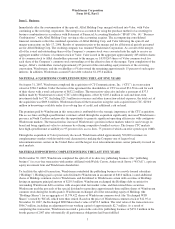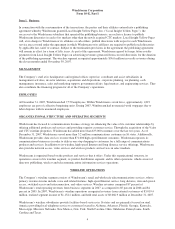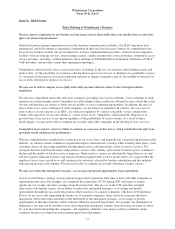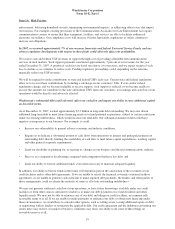Windstream 2007 Annual Report Download - page 56
Download and view the complete annual report
Please find page 56 of the 2007 Windstream annual report below. You can navigate through the pages in the report by either clicking on the pages listed below, or by using the keyword search tool below to find specific information within the annual report.
Windstream Corporation
Form 10-K, Part I
Item 1. Business
High-Speed Internet Services
On March 15, 2002, the FCC issued a declaratory ruling concluding that cable modem service was an interstate
“information service” and not a cable service or a telecommunications service. This ruling was upheld by the United
States Supreme Court. In addition, on September 23, 2005, the FCC released an order declaring Digital Subscriber Line
(“DSL”) offerings, as well as other high-speed Internet access services offered over wireline technologies,
“information services” functionally integrated with a telecommunications component and no longer subject to a higher
level of regulation as compared to cable modem service. The order further provides price cap companies the option to
deregulate high-speed Internet and rate-of-return companies the option to de-tariff high-speed Internet. The Company
elected to deregulate its high-speed Internet services in its price cap properties effective October 2006 and now benefits
from the decreased regulation of its high-speed Internet services, providing the Company with additional retail pricing
flexibility and relief from federal universal service fund contributions. On April 1, 2007, the Company de-tariffed its
high-speed Internet services in certain of its rate-of-return companies, and now benefits from decreased regulatory
oversight and additional retail pricing flexibility in those markets as well. The Company de-tariffed high-speed Internet
services for its remaining rate-of-return companies on July 1, 2007. Rate-of-return properties will continue to include
high-speed Internet service revenues in their federal universal service fund assessable revenue base. The Company’s
high-speed Internet products are experiencing significant growth throughout its service areas, and these recent actions
improve our regulatory position compared to the non-regulated cable modem service, which is our primary high-speed
Internet competitor, thereby helping to level the regulatory playing field.
On November 20, 2007, the FCC released a Notice of Proposed Rule Making (“NPRM”) that tentatively concluded
that all high-speed Internet providers should pay the same pole attachment rate for all attachments used for high-speed
Internet services. Windstream pays approximately $23.0 million annually to rent space on utility poles it does not own.
The NPRM suggests that this rate should be higher than the current cable rate but no greater than the current rate paid
by telecommunications carriers. If the NPRM tentative conclusion is adopted, Windstream would likely see a reduction
in the amounts that it pays to rent space on utility poles it does not own and will be able to better compete with other
companies offering high-speed Internet services.
Communications Assistance for Law Enforcement Act
In 1994, Congress enacted the Communications Assistance for Law Enforcement Act (“CALEA”) to preserve the
ability of law enforcement officials to conduct electronic surveillance effectively and efficiently in the face of rapid
advances in telecommunications technology. The FCC has adopted rules that implement the requirements set forth in
CALEA. Under CALEA, the Company is required to provide law enforcement officials with call content and call
identifying information upon receipt of a valid electronic surveillance warrant. The Company is compliant in all
material respects with all CALEA requirements.
Customer Proprietary Network Information
Customer Proprietary Network Information (“CPNI”) includes information such as the phone numbers dialed,
frequency of calls, duration of calls and retail services purchased by a customer. The Telecommunications Act of 1996
requires service providers to ensure the confidentiality of CPNI and provides that CPNI may be used, disclosed or
shared only if required by law, the customer has given consent, or CPNI is necessary for the provision of services from
which CPNI was derived. The FCC has implemented rules that require service providers to establish safeguards to
prevent the unauthorized disclosure of CPNI.
On April 2, 2007, the FCC released an order and adopted a further notice of proposed rulemaking to alter the
requirements to safeguard customers’ CPNI. The order prohibits carriers from disclosing call detail information based
on customer-initiated telephone contact except when the customer provides a password or, if the customer does not
provide a password, the carrier may only disclose the requested call detail records by sending them to the customer’s
address of record. The order further requires carriers to obtain explicit consent from customers when releasing CPNI to
third parties for the purposes of marketing retail services to that customer. The order also establishes a notification
process for law enforcement and customers in the event of a CPNI breach, requires that carriers provide notice to
customers immediately following certain account changes and requires carriers to file annual certifications of CPNI
10
























